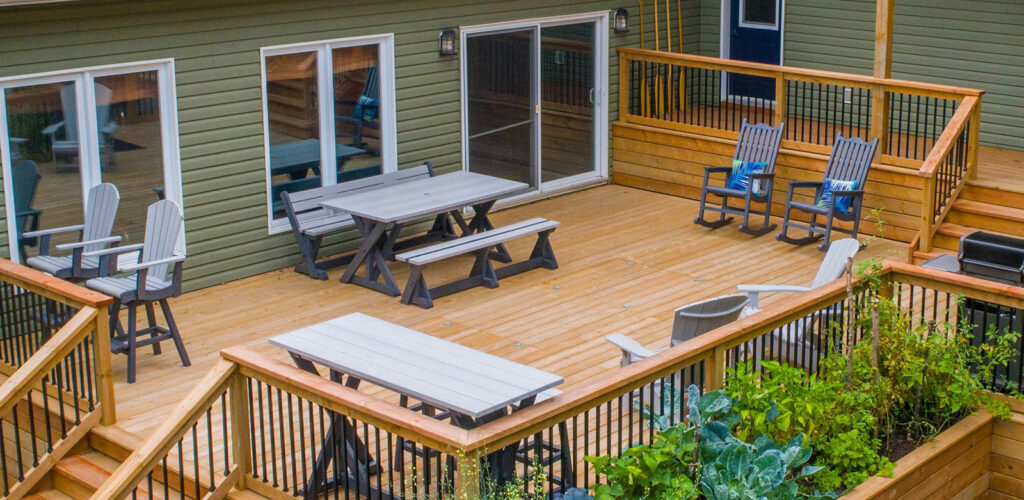How to Stain a Deck (Step-by-Step Guide for Lasting Beauty)
Key Takeaways
The exact steps for cleaning, prepping, and staining a wood deck so the finish lasts.
How to choose between transparent, semi-transparent, and solid stains.
Pro tips to avoid common mistakes and when it makes sense to hire a professional.
A freshly stained deck does more than refresh color—it shields the wood from moisture, sun damage, and everyday wear. Here in Southern Oregon’s Rogue Valley, wet winters, hot summers, and heavy UV exposure can quickly fade and crack untreated cedar, redwood, and pressure-treated lumber. Following the right process is the key to a finish that looks great and protects your investment for years.
Here’s how a DIY(er) can do a professional deck staining job.
1: Inspect and Prepare the Deck
Before you start staining, give the deck a thorough inspection.
Check for Damage
Look for loose boards, popped nails, or rot. Stain can’t fix structural problems, so repair these first.
Clear the Space
Remove furniture, planters, and rugs, then sweep away leaves and debris. A clean surface helps every other step go smoothly.
2: Clean the Wood
A spotless surface ensures even stain penetration.
Pressure or Soft Washing
Perform a low-pressure, deck pressure washing or soft washing technique to remove moss, algae, and grime. Keep the nozzle moving to avoid gouging softer woods like cedar.
Wood Cleaner for Stubborn Spots
If mildew or heavy pollen lingers, apply a deck-safe cleaner and rinse thoroughly. Allow the deck to dry 24–48 hours, longer if the humidity is high.
3: Sand for a Smooth Finish
Light sanding opens the grain and removes any raised fibers.
Use 80–100-grit sandpaper and/or a power sander.
Pay special attention to railings and high-traffic boards for a splinter-free surface.
4: Choose the Right Stain
Your stain choice affects both appearance and durability.
Transparent Stains
Highlight the wood’s natural grain but provide the least UV protection—best for newer decks in shaded spots.
Semi-Transparent Stains
Balance color with visible grain. A popular pick for cedar and redwood, they offer stronger sun protection while showcasing natural beauty.
Solid (Opaque) Stains
Deliver the strongest UV defense and can hide older discoloration. Ideal when you want bold, uniform color.
5: Apply the Stain
Plan for a dry day with temperatures between 50–80 °F.
Use a high-quality brush or pad applicator for even coverage.
Work with the grain, coating two or three boards at a time to prevent lap marks.
Apply a second coat only if the product recommends it.
6: Let It Cure
Allow the deck to dry at least 24 hours before replacing furniture or walking on it. Always follow the drying times listed on the stain can; cool, damp weather may require longer.
Pro Tips for Long-Lasting Results
Test a small area first to confirm color and absorption.
Avoid staining in direct midday sun, which can cause streaks.
Rinse off light dirt annually to extend the finish.
When to Hire a Professional
While this guide shows how to properly stain a deck, the job can be labor-intensive and weather-dependent. If you’d like a quote on the cost to restain your deck, we would be happy to give you a free quote (click here). We use professional-grade cleaning equipment and premium stains that stand up to Southern Oregon’s wet winters and intense summer sun, saving you time and ensuring a flawless, long-lasting result.
Knowing how to stain a deck the right way protects your outdoor space and keeps it beautiful season after season. Whether you tackle it yourself or call in the experts, these steps will help your deck stay vibrant, safe, and ready for years of backyard gatherings.
FAQs
Most wood decks in Southern Oregon need staining every 2–3 years, depending on sun exposure, foot traffic, and the type of stain used.
Yes. Cleaning is essential to how to properly stain a deck. A gentle pressure or soft wash removes moss, algae, and dirt so the stain can soak in evenly.
It’s possible but not ideal. Light sanding after cleaning opens the grain and gives a smoother finish—an important step in how to stain a deck for long-lasting results.
Aim for a dry day with temperatures between 50–80°F and no rain in the forecast for at least 24 hours. Humid or very hot weather can cause uneven absorption.
Cleaning and prep often take a day or two (including drying time). Staining itself may take 4–8 hours depending on deck size and detail work.
